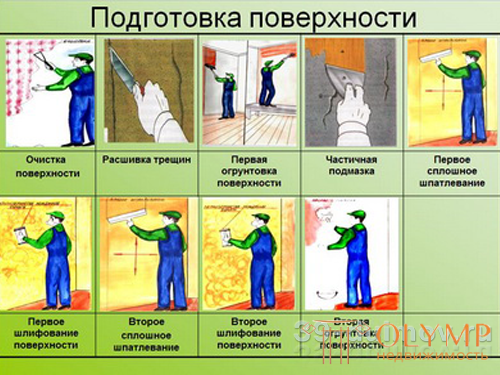
Surface coloring consists of a series of sequentially performed operations that can be divided into preparation for coloring HIM mediocre coloring. The operations of preparing the substrate for painting include: cleaning and leveling the surface of the substrate, priming the surface (polishing), putty, grinding and second priming.
The surface to be painted must be dried, cleaned of dust and dirt, splashing solution, grease, corrosion and carefully leveled. The rough surfaces of the plaster smooth down, small cracks are embroidered and sealed with a solution to a depth of at least 2 mm. Plastered surfaces after they are smoothed out are smoothed with a pumice stone or wooden block, metal surfaces are cleaned of rust with metal brushes or sandblaster.
The moisture content of the plastered or concrete surface before painting should not exceed 8%, wooden surfaces - 12%, more wet surfaces can be painted, but only with lime, cement and silicate paints. Painting on previously painted surfaces is carried out only after thorough cleaning of the old damaged paint and putty. Before painting the surface is primed, spatula and grind.
Depending on the quality of readiness of the surface for coloring, they are divided into four groups:
1) concrete and gypsum concrete, not requiring putty;
2) revetted with fibreboard, crack sealing and
putty on which produced approximately 15% of the area;
3) plastered, sealing of cracks and putty which occupies approximately 35% of the area;
4) surfaces, on the whole area of which it is necessary to perform the sealing of cracks and putty.
Cleaning the surface from dust produced by compressed air or brushes. Pollution, greasy and tar stains are removed with a rag, steel spatulas, various solvents are used. Metal surfaces are cleaned from rust with spatulas, brushes, scrapers, pneumatic and electrical grinders. For large areas of the surfaces being cleaned, it is advisable to use sandblaster.
Ogruntovka (application of a preparatory layer) —the pre-painting with liquid paint formulations — is carried out with the aim of impregnating the surface, which will ensure a firm adhesion of subsequent paint layers to it and will give the surface uniformity. i Primers for glue color are made on the basis of vitriol (0.3 kg of copper sulphate, 0.25 kg of tile glue and 0.3 kg of laundry soap are used for 10 liters of water), apply limestone, soap maker, alum and others. Calc and casein coloration makes a lime primer, for oily colouration the surface is coated with linseed oil.
When preparing the surface for painting with water compositions, priming is carried out several times - before partial lubrication of individual places, before applying each layer of putty and before painting; vro provides anchoring and leveling the base. Soil is applied to the surface with rollers and brushes, mechanized spraying - with the help of paint rods and sprays.
The preparation of the surface for painting is done manually by means of polishing the base with brushes or rollers. AT 






 A small amount of pigment is added to the linseed oil (5 ... 10%) or the finished paint for priming the surface is diluted with linseed oil in a ratio from 1: 8 to 1:10. The presence of pigment in the primer composition allows, in the course of the work, to find possible gaps on the surface and immediately to ground them. Apply drying oil oxol, which under favorable conditions dries per day. Applying to a still wet base putty or paint composition leads to the formation of bubbles and peeling of the coating. For priming in recent times are beginning to widely apply water-oil primer instead of drying oil.
A small amount of pigment is added to the linseed oil (5 ... 10%) or the finished paint for priming the surface is diluted with linseed oil in a ratio from 1: 8 to 1:10. The presence of pigment in the primer composition allows, in the course of the work, to find possible gaps on the surface and immediately to ground them. Apply drying oil oxol, which under favorable conditions dries per day. Applying to a still wet base putty or paint composition leads to the formation of bubbles and peeling of the coating. For priming in recent times are beginning to widely apply water-oil primer instead of drying oil.
Lubrication - filling of rough irregularities on the treated surface with putty compositions: cracks in wooden structures, cracks in the plaster, damaged places on concrete surfaces.
Surface filler - application of putty to the primed surface with an even layer of 1 ... 3 mm. Depending on the binder, putty pastes make adhesive, oil, oil-adhesive and varnish. When applying pastes to the surface with the manual method, wooden, metal and rubber spatulas of various sizes and designs are used. With the mechanized method found air diffusers and mechanized spatulas, the composition is applied to the surface under pressure. Depending on the requirements for painting the surface, the surface is spatula one or more times with intermediate sanding and priming. Paste for grease should be thick, for putty - medium consistency.
Grinding - smoothing the surface and removing all irregularities on it after each greasing and filling with a pumice stone or abrasive cloth manually, pneumatic or electroplating machines.
Painting compositions and semi-finished products are prepared in special workshops and in mobile painting stations, which include paint markers, mixers, grinders, glues cookers, vibrating screens.

Что бы оставить комментарий войдите
Комментарии (0)